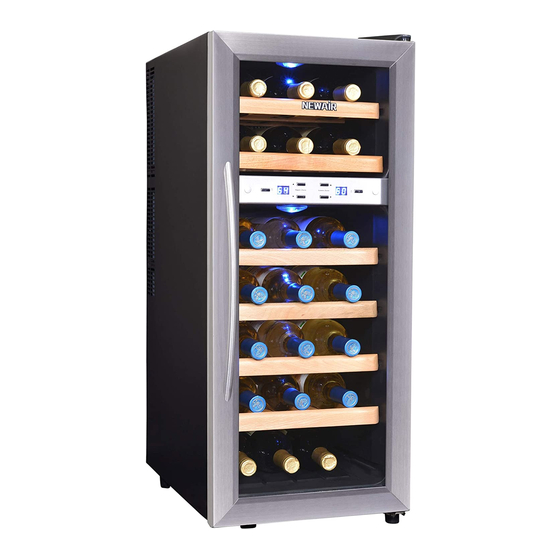
Summary of Contents for NewAir AW-211ED
- Page 1 INSTRUCTION MANUAL Thermoelectric Wine Cooler MODEL: AW-211ED Please carefully read and follow all safety rules and operating instructions.
-
Page 2: Important Safety Instructions
Product Diagram 1. HINGE 2. LIGHT 3. TEMPERATURE CONTROLLER 4. TEMPERATURE DISPLAY 5. FAN MASK 6.SHELVES 7. FEET 8.DOOR FRAME 9. GLASS DOOR 10. DOOR HANDLE Important Safety Instructions To reduce the risk of fire, electrical shock, or injury when using this appliance, follow these basic precautions: Read all instructions before operating the wine cooler. -
Page 3: Installation Instructions
Installation Instructions Before operating your wine cooler for the first time, follow these steps: Remove the exterior and interior packaging. Check to make sure the following parts are included: 7 slide-out shelves 1 instruction manual Before connecting the unit to a power source, allow it stand upright for approximately 2 hours. This will reduce the possibility of any system malfunctions which may have occurred from handling during transportation. -
Page 4: Operating Your Wine Cooler
Operating Your Wine Cooler It is recommended that the wine cooler be installed in an area where the ambient temperature is between 10-26 ۦC (50- 80° F). If the ambient temperature is above or below the recommended ranges, the unit’s performance may be affected, and extreme cold or hot conditions may cause the interior temperature to fluctuate. -
Page 5: Troubleshooting
Troubleshooting To troubleshoot your wine cooler, follow the suggestions below to address the most common problems before seeking assistance from a service center: PROBLEM POSSIBLE CAUSES • The wine cooler will not operate. The unit may be plugged in using a different voltage. Also, the circuit breaker may be tripped or there is a blown fuse.

















Need help?
Do you have a question about the AW-211ED and is the answer not in the manual?
Questions and answers